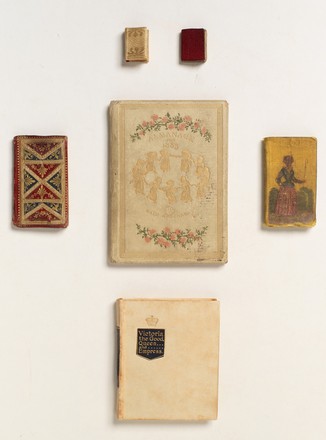
A selection of miniature books
1700s and 1800s
Bound volumes
The London Almanack: For the Year of Christ 1792
London: printed for the Company of Stationers, 1792
Bequest of Sir William Dixson, 1952
SAFE/ 79/87
The London Almanack: For the Year of Christ 1765
Miniature book
London: printed for the Company of Stationers, 1765
Bequest of Sir William Dixson, 1952
SAFE/ 76/11
Galileo a Madame Cristina di Lorenza,1896
Miniature book
Padova: Tip. Salmin, 1896
Bequest of Sir William Dixson, 1952
SAFE/ 89/586
Schloss' English Bijou Almanac
‘poetically illustrated’ by S Lover’, 1840
Miniature book
London: A Schloss, 1840
Bequest of Sir William Dixson, 1952
SAFE/ 84/456
Almanac for 1883
by Kate Greenaway
Miniature book
London: G Routledge, 1883
Bequest of Sir William Dixson, 1952
SAFE 88/649
Victoria, the Good Queen and Empress,1897
Miniature book
London: Gardner, Darton & Co, 1897
Bequest of Sir William Dixson, 1952
SAFE/ 89/587
Bound volumes
The London Almanack: For the Year of Christ 1792
London: printed for the Company of Stationers, 1792
Bequest of Sir William Dixson, 1952
SAFE/ 79/87
The London Almanack: For the Year of Christ 1765
Miniature book
London: printed for the Company of Stationers, 1765
Bequest of Sir William Dixson, 1952
SAFE/ 76/11
Galileo a Madame Cristina di Lorenza,1896
Miniature book
Padova: Tip. Salmin, 1896
Bequest of Sir William Dixson, 1952
SAFE/ 89/586
Schloss' English Bijou Almanac
‘poetically illustrated’ by S Lover’, 1840
Miniature book
London: A Schloss, 1840
Bequest of Sir William Dixson, 1952
SAFE/ 84/456
Almanac for 1883
by Kate Greenaway
Miniature book
London: G Routledge, 1883
Bequest of Sir William Dixson, 1952
SAFE 88/649
Victoria, the Good Queen and Empress,1897
Miniature book
London: Gardner, Darton & Co, 1897
Bequest of Sir William Dixson, 1952
SAFE/ 89/587
These miniatures date from the 18th and 19th centuries, when miniature bibles, dictionaries and almanacs were the most popular editions. From the 19th century on, Children’s books, editions of Shakespeare and novels became increasingly popular, adding to the range of titles being produced in miniature form.
Although small in size, miniature books have had a big impact on the development of printing and bookbinding because of the exacting and intricate demands of their production. Miniature books require very fine paper, clear engravings and perfectly proportioned type. Binding requires particular skill and often included the production of a small carry in case with a magnifier.


 Back to list
Back to list